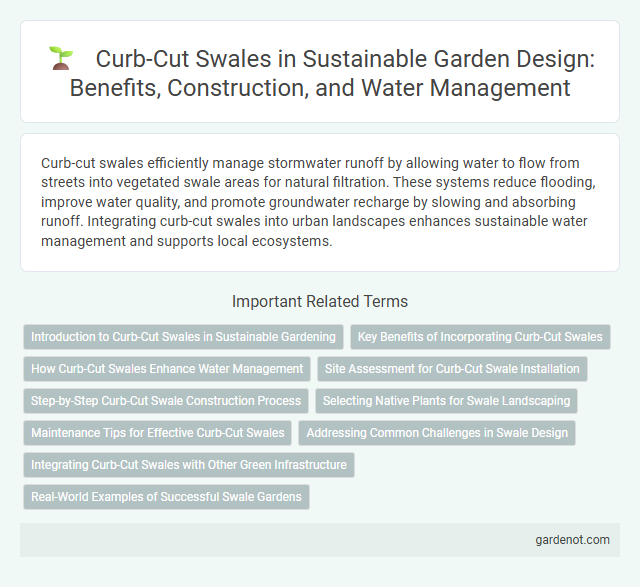Curb-cut swales efficiently manage stormwater runoff by allowing water to flow from streets into vegetated swale areas for natural filtration. These systems reduce flooding, improve water quality, and promote groundwater recharge by slowing and absorbing runoff. Integrating curb-cut swales into urban landscapes enhances sustainable water management and supports local ecosystems.
Introduction to Curb-Cut Swales in Sustainable Gardening
Curb-cut swales are designed to capture and redirect stormwater runoff from urban streets into vegetated swales, promoting groundwater recharge and reducing erosion. These swales incorporate strategically placed curb openings that allow water to flow directly into the garden bed, enhancing natural filtration and supporting native plant growth. Implementing curb-cut swales in sustainable gardening improves water management while minimizing flood risks and supporting local ecosystems.
Key Benefits of Incorporating Curb-Cut Swales
Curb-cut swales enhance stormwater management by directing runoff from impervious surfaces into vegetated channels, reducing flooding and improving water quality. These features promote groundwater recharge and filter pollutants naturally, which helps protect local waterways from contaminants. Incorporating curb-cut swales supports urban sustainability by mitigating erosion and lowering infrastructure maintenance costs associated with stormwater damage.
How Curb-Cut Swales Enhance Water Management
Curb-cut swales enhance water management by directing stormwater runoff from impervious surfaces into vegetated channels, promoting natural infiltration and reducing surface flooding. These swales filter pollutants and sediments, improving urban water quality and mitigating the impact on local waterways. By slowing water flow and increasing groundwater recharge, curb-cut swales support sustainable urban drainage systems and reduce the burden on municipal stormwater infrastructure.
Site Assessment for Curb-Cut Swale Installation
Site assessment for curb-cut swale installation involves evaluating soil permeability, slope gradient, and existing drainage patterns to ensure effective stormwater infiltration and runoff control. Identifying potential obstructions such as underground utilities and tree roots is crucial to avoid structural damage and maintain long-term swale functionality. Accurate site analysis optimizes design parameters, enhancing water quality improvement and flood mitigation in urban landscapes.
Step-by-Step Curb-Cut Swale Construction Process
Constructing a curb-cut swale begins with identifying the appropriate location along the roadway where stormwater runoff naturally accumulates. Excavation follows, creating a shallow, elongated depression adjacent to the curb with a slight slope to facilitate water flow and infiltration. Final steps include installing an overflow outlet, amending the soil with organic material to enhance permeability, and planting native vegetation to stabilize the soil and improve water quality.
Selecting Native Plants for Swale Landscaping
Selecting native plants for curb-cut swale landscaping enhances water absorption and supports local biodiversity by using species adapted to regional climate and soil conditions. Deep-rooted native plants such as sedges, rushes, and wildflowers improve soil stability and filtration, reducing runoff and pollutant load. Incorporating diverse native vegetation ensures resilient swale performance and contributes to sustainable urban water management.
Maintenance Tips for Effective Curb-Cut Swales
Regular inspection of curb-cut swales ensures debris and sediment do not block water flow, maintaining optimal drainage performance. Removing accumulated leaves and trash prevents clogging and preserves the swale's ability to filter pollutants effectively. Periodic vegetation management, including trimming and replanting native species, supports soil stabilization and enhances water infiltration.
Addressing Common Challenges in Swale Design
Curb-cut swales effectively manage stormwater by directing runoff from streets through carefully designed openings, reducing surface water accumulation and erosion. Proper placement and sizing of curb cuts prevent clogging by sediment and debris, ensuring consistent water flow and infiltration. Incorporating engineered soil media and vegetation enhances pollutant removal while maintaining structural stability under varying flow conditions.
Integrating Curb-Cut Swales with Other Green Infrastructure
Curb-cut swales enhance stormwater management by directing runoff from streets into vegetated channels, effectively reducing pollution and peak flow rates. Integrating curb-cut swales with permeable pavements, rain gardens, and bioswales creates a comprehensive green infrastructure network that improves infiltration and groundwater recharge. This synergy not only mitigates urban flooding but also supports habitat creation and urban cooling in built environments.
Real-World Examples of Successful Swale Gardens
Curb-cut swales effectively manage stormwater by directing runoff from streets into planted areas, reducing erosion and improving water quality. In Portland, Oregon, curb-cut swale installations have decreased urban flooding by channeling rainwater into bioswales, supporting native vegetation and urban wildlife habitats. These examples demonstrate how integrating curb-cut swales in city planning enhances sustainable water management and urban green infrastructure.
Curb-cut swale Infographic

 gardenot.com
gardenot.com